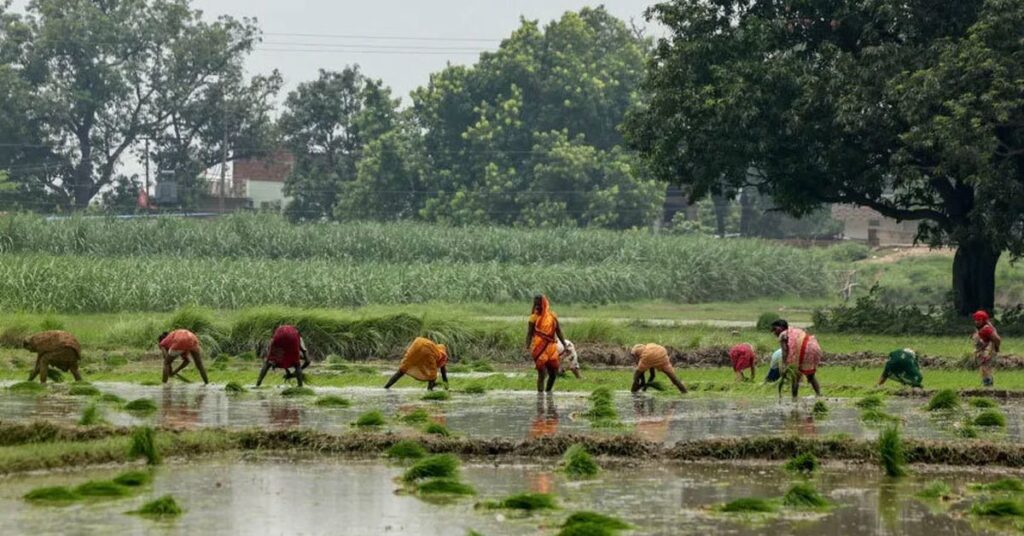
Her arm was the first thing Shyam Babu saw, tiny and frail, poking through the mud like a discarded doll. But this was no doll. Covered with ants and bleeding from what doctors would later suspect were animal bites, the pig farmer had just made a terrifying discovery near a river in this north Indian village.
Wrapped in a towel, barely stirring, but slightly breathing, was a newborn baby girl buried beneath a foot of earth. “I went closer and saw that the child’s fingers were moving. I went even closer and could sense a heartbeat,” Babu recalled as he retraced his steps leading to the horrific discovery last month in the sugarcane and paddy fields of rural Shahjahanpur district in Uttar Pradesh state. “I realised the child was alive…. Someone had buried a baby alive.”
Terrified, he ran to raise the alarm. Soon a crowd was at the scene. In a frantic but delicate rescue, captured on images and video reviewed by CNN, a policeman dug away the packed earth. The girl, later estimated to be about 15 days old, was completely smeared in mud. Gasping for air, her mouth and nostrils clogged with dirt. As she was lifted from the ground, she let out a weak, painful cry.
Medical Intervention and Investigation
Rushed to the Shahjahanpur Medical College, she was found to have a severe infection, respiratory distress, injuries, and sepsis. The local police started searching for the girl’s parents – and a motive. Gourav Tyagi, a local officer investigating the case, told CNN they had three theories. Her parents could have believed their sickly child had died and buried her according to local customs. The newborn had syndactyly, a condition where two or more fingers or toes are joined together and could have been abandoned owing to the stigma around disabilities in parts of India.
And there was another angle: that she was discarded because of her gender, another victim of female infanticide in the world’s most populous nation, where a deep-seated preference for sons can lead to girls being abandoned or killed. Dr. Rajesh Kumar, a pediatrician in Shahjahanpur for two decades, told CNN he has seen four or five such cases before. But he noted: “I have never seen a boy in such a situation… left alone and abandoned.”
“There is pressure to birth a boy. A woman faces a lot of difficulty. They do not want girls so the woman goes to temples and does rituals to have a boy.”
Gender Bias and Cultural Pressures
In the quiet hush of the neonatal intensive care unit at Shahjahanpur Medical College, the only constant sound was the monotone of the heart monitor, its low hum keeping watch over the baby sleeping inside the sterile incubator. When she first arrived there, she was clinging to life. Her face was blue from a lack of oxygen, her body temperature dangerously low, and her blood pressure was so faint it was unrecordable. Against all odds, doctors initially saw a flicker of hope.
“Miracles do happen,” Dr Kumar told CNN at the time, as the medical equipment worked to keep the tiny girl alive. “Our hospital staff is taking care of her like family. Our nursing staff, ward nannies, and doctors are all taking care of her like she is our child.” Soon they had given her a name – Pari, the Hindi word for “angel.”
Shahjahanpur district, where Pari was found, lies in the fertile, populous plains of north India. It is overwhelmingly rural, with most of its three million people working in agriculture. Paddies and wheat fields line the meandering roads between villages. The holy river Ganges skirts the district’s southern border.
Beneath the surface of this agrarian life, traditional gender roles exert a powerful force. And it is this culture that paralysed Babu, 25, with fear after he found Pari. “I did not have the courage to take the child out myself. I feared that people would see me, think the wrong things, and blame me instead,” Babu said, before he ran to find his mother.
“If they find out it is a boy then it is okay. If it is a girl, then they get her aborted.”
Historical Context and Ongoing Challenges
According to the last national census in India, carried out in 2011, Shahjahanpur had about 872 females for every 1000 males, a wider gap than a national average already imbalanced. That imbalance, activists and locals say, is partly due to a deeply entrenched system of cultural, economic, and social biases that systemically devalues girls – and the desirability of raising them.
“There is pressure to birth a boy,” said 60-year-old Nanhe Singh, from Shahjahanpur’s Paina Bujurg village close to where Pari was found. “A woman faces a lot of difficulty. They do not want girls so the woman goes to temples and does rituals to have a boy.”
The preference for sons is rooted in a patriarchal structure where boys are expected to carry on the family lineage, inherit property, and perform essential last rites for their parents. Daughters, on the other hand, are often perceived as a significant financial liability.
“One of the biggest issues with having a girl is the tradition of dowry” – the money or property that is often demanded by a groom’s family at a wedding, vegetable seller Achal Kumar Gautam, 32 told CNN. Despite being outlawed, this is a “tradition going on for generations and has to be followed,” he said.
With such pressure to give birth to a son, some women turn to medical procedures to find out if they are carrying a boy or a girl, said another villager from Paina Bujurg, Sapna Singh. “If they find out it is a boy then it is okay. If it is a girl, then they get her aborted. This happens here,” the 28-year-old said. “People do this inside their homes, and no one gets to know outside.”
To combat female feticide, India enacted a law in 1994 prohibiting the use of medical technologies to determine the sex of a fetus. Yet, in these labyrinthine lanes of rural India, a dangerous and illegal abortion trade thrives. Shahjahanpur’s superintendent of police Rajesh Dwivedi told CNN sex determination tests “have severely reduced over time,” while acknowledging that it continues to happen “on the sly.”
“We cannot change everything, but immense change has happened,” he said.
Broader Implications and Future Prospects
According to activist Sunita Aralikar, illegal sex determination “is something that goes on in households of all classes.” Aralikar, who herself survived being buried alive as a baby 70 years ago, has dedicated her career to empowering women and fighting the deep-seated cultural biases that devalue girls. She sees this latest tragedy as proof of how little has changed.
“This association of glory and success with a boy child, and failure and burden with a girl child is something that cuts across the country,” she said.
A United Nations State of World Population report estimated India had 45.8 million “missing females” as of 2020 – a staggering figure driven by a combination of sex-selective abortions before birth and higher death rates for girls due to infanticide after birth.
According to Sapna Singh, families in her village often “scare and threaten” women who become pregnant. “They tell her they only want a son,” she said, adding that the pressure can escalate dramatically. “They beat her up. Many people kill women if they are not birthing boys. It is not the woman’s fault. They beat her, threaten her, and abuse her.”
Kamaljeet Kaur, who has spent 18 years as a health volunteer in the villages of Shahjahanpur, described gender discrimination and female infanticide as a “systemic issue.” “It happens rampantly here,” she told CNN.
The consequences for women who bear multiple daughters can be devastating, Kaur said. “If a woman has daughters, especially a second or a third, her life turns into hell,” she said. “Men are continuing to follow old traditions and customs. She is abused, told she has no brains… her position in the family is based on whether she has a son or daughter.”
“This relentless abuse,” Kaur noted, “strips women of their voice, turning them into ‘a mute spectator to everything happening to her.’ And the silence is brutally enforced by the community itself.”
Local media reports from across Uttar Pradesh paint a similarly bleak picture. In November of last year, a baby discovered by a roadside in Gorakhpur was treated by doctors and survived. That same month, residents in Bareilly discovered a 20-day-old girl abandoned in a field. In December, a 10-day-old baby girl was found dead in a garbage dump in the city of Baghpat.
This grim reality evokes a sense of sorrow and powerlessness among women in Paina Bujurg. Nanhe Singh said she was aware of Pari’s case.
In the Shahjahanpur hospital, the first 24-hours after Pari was found gave the medical staff cause for hope. But then her condition deteriorated fast. Necrosis – the death of body tissue – progressed to her face and scalp. Her breathing grew increasingly laboured, and doctors had to place her on oxygen support. She required a blood transfusion to keep her alive.
At two weeks old, Pari was severely malnourished and weighed less than 1.7 kilograms (3.7 pounds), making it difficult for her body to ward off any infection. After a CNN team had left the area last month, police officer Gourav Tyagi confirmed that Pari had died. The police had still not managed to track down her parents and were widening their search, he told CNN.
“I did not have words when she passed away. It was hard to unplug all the monitors and let the baby go,” said Sarita Singh, the nurse in charge of the newborn unit at the hospital. “We were her family.”
Staff did not want her life to be defined by tragedy. “When she came here, she looked beautiful,” Singh said. “Which is why we named her Pari.”
In 2015 Prime Minister Narendra Modi’s government launched its “Beti Bachao, Beti Padhao” or “Save the Girl Child, Educate the Girl Child” campaign to address India’s skewed ratio of children and to promote women’s empowerment. The government says the program has brought wider attention to gender discrimination and seen some success. The country’s national sex ratio at birth rose from 918 girls per 1,000 boys in 2014-15 to 934 in 2019-20, according to data published by the government.
The gross enrollment ratio for girls in secondary education has increased from 77 per cent to 81 per cent in the same period, the same data showed. However, the program has also faced some criticism. A parliamentary committee in 2021 noted that a disproportionately large percentage of the scheme’s funds – nearly 79 per cent between 2016 and 2019 – was spent on media advocacy rather than on concrete health and education initiatives for girls.
“Some people drown the child… some bury her under the ground. Many people just give the child away in hospitals. They don’t even take the girl child home.” – Sarita Singh, nurse, Shahjahanpur Medical College
Billboards and broadcasts promoting the campaign to protect and educate India’s girls are now ubiquitous in cities, towns and on the airwaves. But the silence following Pari’s death was deafening. Her story was largely overlooked by the national news channels and failed to spark sustained outrage.
For some, the campaign’s impact also feels superficial. “People say the slogan… but in reality, no one is following it,” Singh, the hospital nurse said. “It has only become a saying.” CNN has contacted the Uttar Pradesh government for a response.
The activist Aralikar believes that creating opportunities for female success is the key to shifting perceptions. “I’m not saying education and opportunities will erase the problem overnight, but it will at least level the playing field… Only when you start to see girls thrive do you believe they’re worth investing in.”
Meanwhile the police investigation and the search for Pari’s parents continues. “There is a deeply regressive thought about girl children that continues to this day,” the nurse Singh said. “Some people drown the child… some bury her under the ground. Many people just give the child away in hospitals. They don’t even take the girl child home.”
For Babu, the man who found Pari, the encounter with her felt like an act of fate. He usually walks his pigs down a different path, closer to the river, he told CNN. “But because destiny had it that I’d have to save her life, I ended up here,” he said, pointing to the area near the road.
“My wife was very worried. She kept saying I should bring the baby home so we can look after her… I would work harder as a labourer and raise her. We would never cause any harm to our children.”
The father of two girls clung to that sense of purpose all week, watching the news and waiting for updates on the child he believed he had saved. He had already begun to imagine a future for her, hoping she would live a “long life and be brilliant.”
“I have goosebumps,” he said upon learning of her death. “This is wrong.” “I wanted to meet her in the future. Strong, growing, healthy,” he said, his voice heavy with emotion. “I took her out of the soil but she has returned to it.”







